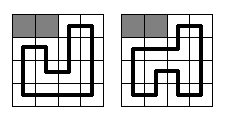ural1519插头DP
2015-07-21 14:57
375 查看
Time limit: 1.0 second |
| input | output |
|---|---|
4 4 **.. .... .... .... | 2 |
4 4 .... .... .... .... | 6 |
依照上面链接分析就非常明白了,情况分清楚了就好写了
#include <iostream>
#include <cstdio>
#include <cstdlib>
#include <cstring>
#include <string>
#include <queue>
#include <algorithm>
#include <map>
#include <cmath>
#include <iomanip>
#define INF 99999999
typedef long long LL;
using namespace std;
const int MAX=300000+10;//最多的有效状态
const int N=10+10;
int n,m,size,index;
int mp
,total[2],bit
,ex,ey;//ex,ey记录最后一个非限制点,total记录有多少状态
int head[MAX],Next[MAX],Hash[MAX];//Hash用哈希查询状态,才用邻接表查询
//对于第i,j格仅仅须要用到第i,j-1格到达,所以才用滚动数组节省内存
LL dp[2][MAX],state[2][MAX],sum;//state记录对应状态,dp记录对应状态可到达的数量
void Init(){
memset(mp,0,sizeof mp);
sum=size=index=0;
total[index]=1;
state[index][1]=0;//初始化仅仅有一种可到达状态:没有不论什么插头
dp[index][1]=1;
}
void HashCalState(LL s,LL num){
int pos=s%MAX;
for(int i=head[pos];i != -1;i=Next[i]){
if(state[index][Hash[i]] == s){
dp[index][Hash[i]]+=num;
return;
}
}
++total[index];
state[index][total[index]]=s;
dp[index][total[index]]=num;
//头插法
Hash[size]=total[index];
Next[size]=head[pos];
head[pos]=size++;
}
void DP(){//才用4进制进行DP,x*4^y=x*2^(2*y)
for(int i=1;i<=n;++i){
for(int k=1;k<=total[index];++k)state[index][k]<<=2;//由上移一行到达这一行(i,0格)在上一行的0号插头前面再加一个插头,去掉最后一个插头(最后一个插头肯定为0)
for(int j=1;j<=m;++j){//求由i,j-1到达i,j的状态以及状态数
memset(head,-1,sizeof head);
size=0;
index=index^1;
total[index]=0;
for(int k=1;k<=total[index^1];++k){//枚举上一格的状态,用来到达i,j某个状态
LL s=state[index^1][k];//取状态
LL num=dp[index^1][k];//取到达对应状态个数
int p=(s>>bit[j-1])%4;//取第j位
int q=(s>>bit[j])%4;//取第j+1位
if(!mp[i][j]){//i,j有限制不能通过,必须绕过
if(p+q == 0)HashCalState(s,num);//仅仅有p=q=0才干到达p'=q'=0的状态,才用哈希计算到达的状态以及个数
}else if(p+q == 0){//i,j无限制则必须有两个插头通过(一进一出)
if(!mp[i+1][j] || !mp[i][j+1])continue;
s=s+(1<<bit[j-1])+2*(1<<bit[j]);//创建新的连通块(添加第j,j+1个插头)
HashCalState(s,num);
}else if(!p && q){//p无插头,q有插头,则新状态须要添加一个插头
if(mp[i][j+1])HashCalState(s,num);//状态不变,连通块不变
if(mp[i+1][j]){
s=s+q*(1<<bit[j-1])-q*(1<<bit[j]);
HashCalState(s,num);
}
}else if(p && !q){//同上
if(mp[i+1][j])HashCalState(s,num);
if(mp[i][j+1]){
s=s-p*(1<<bit[j-1])+p*(1<<bit[j]);
HashCalState(s,num);
}
}else if(p+q == 2){//p=q=1,合并连通块
int b=1;
for(int t=j+1;t<=m;++t){//寻找近期的匹配的括号
int v=(s>>bit[t])%4;
if(v == 1)++b;
if(v == 2)--b;
if(b == 0){
s=s+(1<<bit[t])-2*(1<<bit[t]);//将右括号变为左括号
break;
}
}
s=s-(1<<bit[j-1])-(1<<bit[j]);
HashCalState(s,num);
}else if(p+q == 4){//p=q=2,同上
int b=1;
for(int t=j-2;t>=0;--t){//寻找近期的匹配括号
int v=(s>>bit[t])%4;
if(v == 2)++b;
if(v == 1)--b;
if(b == 0){
s=s-(1<<bit[t])+2*(1<<bit[t]);//将左括号变为右括号
break;
}
}
s=s-2*(1<<bit[j-1])-2*(1<<bit[j]);
HashCalState(s,num);
}else if(p == 1 && q == 2){//合并连通块,仅仅有最后一格的时候才连成整个回路
if(i == ex && j == ey)sum+=num;
}else if(p == 2 && q == 1){
s=s-2*(1<<bit[j-1])-(1<<bit[j]);
HashCalState(s,num);
}
}
}
}
}
int main(){
char ch;
for(int i=0;i<N;++i)bit[i]=i<<1;//求4进制的某位用2进制求须要右移的位数*2while(~scanf("%d%d",&n,&m)){
Init();
for(int i=1;i<=n;++i){
getchar();
for(int j=1;j<=m;++j){
scanf("%c",&ch);
mp[i][j]=(ch == '.');
if(ch == '.')ex=i,ey=j;
}
}
DP();//插头DP
printf("%lld\n",sum);
}
return 0;
}
/*
12 12............
............
............
............
............
............
............
............
............
............
............
............
9 10
..........
..........
..........
..........
..........
..........
..........
..........
..........
*/
相关文章推荐
- 终于找到了。 图标搜索、UI设计、移动开发集中导航
- Linux磁盘分区UUID的获取及其UUID的作用
- SCVMM 2012 R2运维管理十三之:将资源添加到VMM库
- SAS9.3 EM 点击没反应不能打开的解决方法
- [LeetCode]Roman to Integer
- 传:九大前缀,三大后缀
- linux vi(vim)常用命令汇总(转)
- Oracle学习笔记(7)-----------数据更新、事务处理、数据伪列
- 231 Power of Two
- 面试总结(一)——Java基础相关知识
- APP的不同level的保命措施
- hdu 1019 Least Common Multiple
- 前端开发面试知识点大纲--摘自jackyWHJ
- Hadoop生态上几个技术的关系与区别:hive、pig、hbase 关系与区别
- 剑指offer:斐波那契数列的应用
- 矩阵操作
- powerdesigner 16.5 视图的显示
- codevs 1227 方格取数 2(最小费用最大流)
- Centos 7 上使用nginx为Node.js配置反向代理时错误:(13: Permission denied) while connecting to upstream
- POJ-2752

